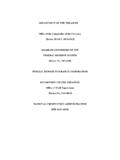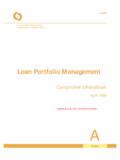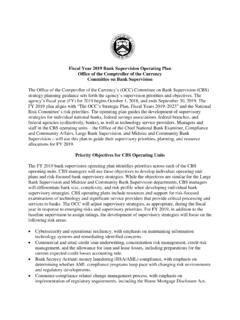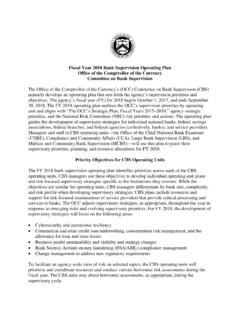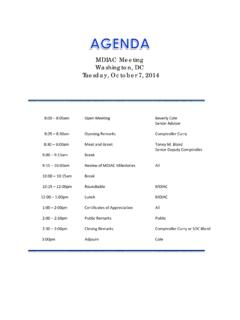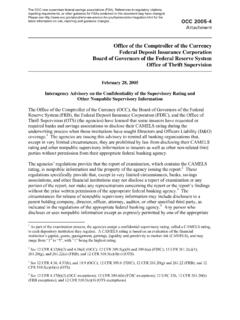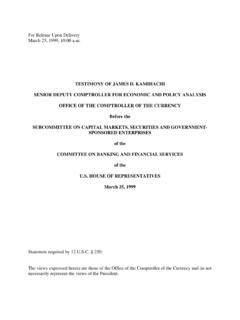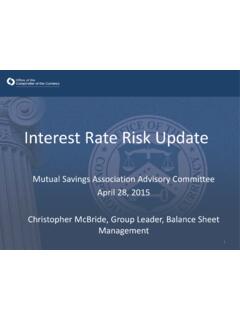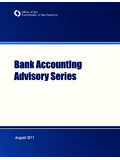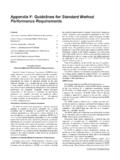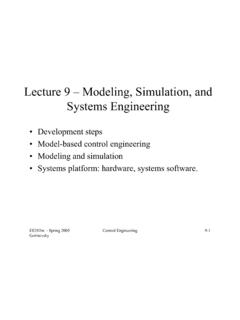Transcription of Model Risk Management
1 Model Risk ManagementVersion , August 2021 () Office of the Comptroller of the Currency Comptroller s Handbook Safety and Soundness Management (M) Earnings (E) Liquidity (L) Sensitivity toMarket Risk (S) Other Activities (O) Asset Quality(A) CapitalAdequacy(C) Version Contents 1 Risks Associated With the Use of 4 Strategic 6 Operational Risk .. 6 Reputation 7 Compliance 8 Credit Risk.
2 9 Liquidity Risk .. 9 Interest Rate 10 Price 10 Risk Management ..12 Governance .. 13 Board and Management Oversight .. 15 16 Model Owners .. 17 Independent Risk Management Staff .. 18 Internal Audit .. 19 Policies and Procedures .. 21 Risk Assessment .. 24 Planning .. 25 Model 26 28 Data Management .. 29 Model Development, Implementation, and Use .. 30 Model Development and Implementation .. 31 32 Ongoing Development .. 33 Model 33 Model Overlays and Adjustments .. 34 35 Model validation .. 36 Evaluation of Conceptual 39 Ongoing Monitoring .. 42 Process Verification .. 43 Benchmarking .. 44 Outcomes Analysis .. 45 Back-Testing .. 47 Third-Party Risk 48 Third-Party Models and 48 Engaging Third Parties for Model Risk Management 50 ITSystems.
3 51 Comptroller s Handbook i Model Risk Management Version Examination Procedures ..53 53 Quantity of 55 Quality of Model Risk 58 82 Internal Control Questionnaire ..84 Glossary ..103 Comptroller s Handbook ii Model Risk Management Version Introduction The Office of the Comptroller of the Currency s (OCC) Comptroller s Handbook booklet, Model Risk Management , is prepared for use by OCC examiners in connection with their examination and supervision of national banks, federal savings associations, and federal branches and agencies of foreign banking organizations (collectively, banks).
4 Each bank is different and may present specific issues. Accordingly, examiners should apply the information in this booklet consistent with each bank s individual circumstances. This booklet aligns with the principles laid out in the Supervisory Guidance on Model Risk Management conveyed by OCC Bulletin 2011-12, Sound Practices for Model Risk Management : Supervisory Guidance on Model Risk Management (MRM Supervisory Guidance). This booklet is designed to guide examiners in performing consistent, high-quality Model risk Management examinations. presents the concepts and general principles of Model risk Management . informs and educates examiners about sound Model risk Management practices that should be assessed during an examination.
5 Provides information needed to plan and coordinate examinations on Model risk Management , identify deficient practices, and conduct appropriate follow-up. Supervisory Guidance on Model Risk Management Throughout this booklet, information from the Supervisory Guidance on Model Risk Management is identified in boxes like this one. Refer to OCC Bulletin 2011-12 for the full text of the supervisory guidance. Certain laws or regulations apply to specific This booklet does not focus on specifics regarding compliance with these laws and regulations, as this booklet s focus is on a bank s Model risk Management for all models. Model risk Management should be commensurate with the extent and complexity of Model usage at a bank.
6 Background Supervisory Guidance on Model Risk Management For the purposes of this document, the term Model refers to a quantitative method, system, or approach that applies statistical, economic, financial, or mathematical theories, techniques, and assumptions to process input data into quantitative estimates. A Model consists of three 1 For example, certain banks must comply with ongoing Model review, approval, and validation requirements as part of the advanced approaches risk-based capital rules, set forth at 12 CFR 3, subpart E, and the market risk rule, set forth at 12 CFR 3, subpart F. Terms that are boldfaced upon first mention in this booklet are defined in appendix A of this booklet.
7 Comptroller s Handbook 1 Model Risk Management Version components: an information input component, which delivers assumptions and data to the Model ; a processing component, which transforms inputs into estimates; and a reporting component, which translates the estimates into useful business information. Models meeting this definition might be used for analyzing business strategies, informing business decisions, identifying and measuring risks, valuing exposures, instruments or positions, conducting stress testing, assessing adequacy of capital, managing client assets, measuring compliance with internal limits, maintaining the formal control apparatus of the bank, or meeting financial or regulatory reporting requirements and issuing public disclosures.
8 The definition of Model also covers quantitative approaches whose inputs are partially or wholly qualitative or based on expert judgment, provided that the output is quantitative in nature. (See note 1.) Note 1: While outside the scope of this guidance, more qualitative approaches used by banking organizations , those not defined as models according to this guidance should also be subject to a rigorous control process. A Model may combine assumptions, data, and hypotheses about the behavior of markets or individuals, and process these inputs into quantitative estimates, forecasted outcomes, or predictions. Supervisory Guidance on Model Risk Management Models are simplified representations of real-world relationships among observed characteristics, values, and events.
9 Simplification is inevitable, due to the inherent complexity of those relationships, but also intentional, to focus attention on particular aspects considered to be most important for a given Model application. Model quality can be measured in many ways: precision, accuracy, discriminatory power, robustness, stability, and reliability, to name a few. Models are never perfect, and the appropriate metrics of quality, and the effort that should be put into improving quality, depend on the situation. For example, precision and accuracy are relevant for models that forecast future values, while discriminatory power applies to models that rank order risks. In all situations, it is important to understand a Model s capabilities and limitations given its simplifications and assumptions.
10 Because assumptions are typically simplifications of the actual relationships between inputs and outputs, and hypotheses about behavior are imprecise, there is some uncertainty associated with a Model s estimate of the outputs, resulting in prediction errors. Various models may focus on discriminatory power or predictive power as measures of Model accuracy. Discriminatory power assesses a Model s rank-ordering property, while predictive power focuses on the Model output s prediction accuracy. A Model focusing on discriminatory power need not produce the most accurate prediction, in the same way a Model with the most accurate predictive power need not produce maximum rank-ordering.
